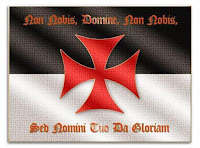Bien étonnés de se trouver ensemble:
quod ubique, quod semper, quod ab omnibus creditum est
and the KKK banner reads
quod semper, quod ubique, quod ab omnibus.
What on earth have these two in common?
The saint
There are several saints called Vincent(ius), and our man here is called after Lérins, the island on which his abbey stood. Under the pseudonym Peregrinus he wrote a famous Commonitorium, whose French translation can be consulted here. In the very first paragraphs (here) he considers the question how to distinguish the "true" belief from heresies, and writes
5. In the catholic church itself, one must take the upmost care to hold on to what has been believed everywhere, always and by everybody, because this is truely and properly "catholic", as shown by the content and the meaning of the very word, and the fact that it covers almost everything universally.
Simply put: something is "catholic" if all catholics have always believed it. (If this sounds like a tautology to you, remember that theology is "the biggest waste of intellect in western history".) Anyhow, the formula
what has been believed everywhere, always and by everybody
was coined here (in Lérins) and then (ca.435). The context shows that "everybody" should be understood as "every catholic", because otherwise nothing satisfies the criterion. Our holy writer proves this trivial fact by mentioning a lot of heretics, who do not believe what catholics believe.
St. Vincent gives his triple as
quod ubique, quod semper, quod ab omnibus
but he's often quoted in a different order:
quod semper, quod ubique, quod ab omnibus.
This is not only the case in dictionaries as here (Merriam-Webster, since 1828), but even in Vatican documents, as here (1995, signed by the later pope).
The Klan
The original Kuklux Klan was founded in 1867 in Pulaski, Tennessee. Its Prescript is preserved, and can be read here. The abbreviation * stands for "Klan" and * * for "Kuklux Klan", in two words and not three as later. Among the founders there must have been men of a certain cultural level. Thus the fanciful jargon refers not only to dragons and wizards, known to everybody, but also to the yahoos from Swift's Gulliver's Travels. Every page of the text is bordered above and below by a quotation in Latin or French. This need not prove that the author knew either of these languages, because he could find whole lists of such quotes in any dictionary. It would rather seem that the author did not now Latin, because he systematically uses Magi (the plural of Magus) as if it were singular.
The Ensign or Grand Banner of the Klan is described as follows
and here is one of the very few extant copies:
Now a black animal on a yellow field with a red scalloped border does occur in heraldry, for instance:
 |
| or, a raven sable, and a bordure engrailed gules |
but heraldry does not allow text. Possibly the KKK designer thought of something like the Templars' war flag, of which some have (erroneously) believed that it displayed a Latin verse (see here).
No doubt, the field and border of the KKK banner are inspired by some non-trivial example, but I am not aware of which one. The text on it is St. Vincent's (minus creditum est) and the KKK author provides a footnote with a translation. Where St. Vincent wrote "believed" (creditum est), his KKK interpreter writes "held to be true". In a way, he's entitled to do so, because his Latin motto has no verb at all.
The black animal to be painted on it is described as a draco volans (flying dragon), and for its meaning the author refers to
Surprise! The intended KKK flying dragon is not a dragon at all, but some lizard of the East Indies, small and inoffensive! Those who painted the banners did not follow the designer's reference, and preferred a terrifying winged dragon to a peaceful lizard. Whether this was ignorance, carelessness or a deliberate choice is impossible to say. Anyhow, the lizard has never been used, but the dragon has. Below (taken here), a KKK rider carrying the banner.
If the image is enlarged and tilted, the dragon's wings and claws can be distinguished. Note that a lizard has five toes, a dragon three.
Summarising, the information gathered in this post leaves everything in the KKK banner unexplained:
- the yellow field with the red scalloped border
- the weird lizard (an innocent animal with a terribly sounding name)
- the Latin motto insisting on truth (at least in the translation).
Soon after the first Prescript, a revised edition was printed (read it here), but there the Ensign has disappeared altogether, both the Officer of that name and his precious flag!
*








